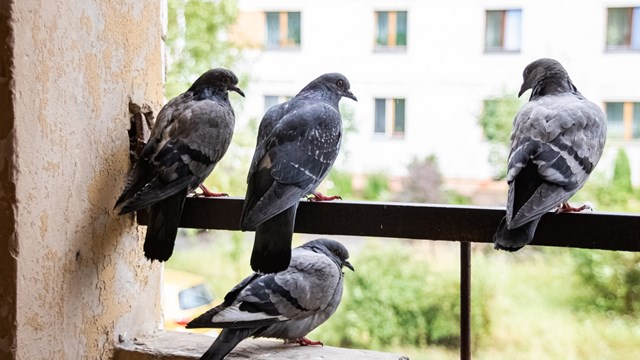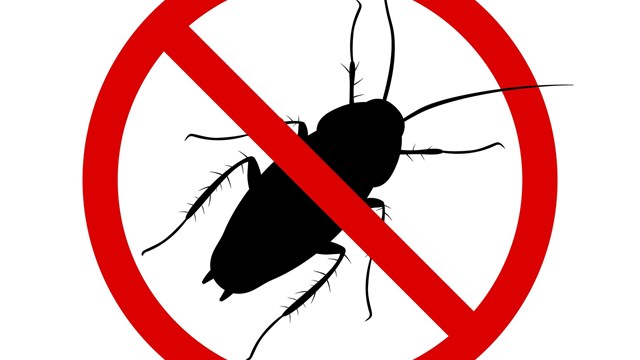
When most managers and condo-dwellers think of “pests,” they're probably thinking of mice and bugs—especially if they live in an urban area. But in semi-rural and even suburban New Jersey, any number of animals can make nuisances of themselves: migrating geese can befoul golf courses, deer can chew hedges into mulch, and gophers, raccoons, and squirrels can devastate landscaping, strew garbage for blocks, and infringe on residents’ peace and quiet. In recent years, bears have even begun to join the fray as housing developments encroach on their natural habitat.
Indeed, there seems to be no limit to the critters that pest control companies are brought in to remove. “Everything under the sun,” says Dan Bradbury, vice president of Viking Pest Control in Denville. “Raccoons, squirrels, groundhogs, snakes, deer. We’ve even gotten calls for bears, foxes, and coyotes.”
Real Risks
While larger wildlife nuisance animals are more rare than say, field mice or ants, they have the potential to cause greater trouble because of their size. They can damage structures and amenities, menace residents, and even spread disease. “Squirrels and raccoons can get into buildings and destroy material,” Bradbury says. “They pull apart insulation, and their droppings are a sanitation hazard. But the biggest threat is electric fires, from them gnawing through wiring,” Bradbury says. “That’s fairly common.”
“Animals can do a surprising amount of damage to a home,” agrees Joe Kosakowski, owner of Wildlife Control Specialist, a company in Lebanon specializing in non-traditional pests. “Whether it is the chewing of rodents, the removal of a screen by a raccoon, the droppings of a colony of bats, or the digging of a skunk.”
And then there’s the chance that you, your kids, or your pet might come into contact with a wild animal—perhaps one with rabies. Rabies is rare in humans, but can still be spread by close contact with contaminated wildlife, including bats, raccoons and squirrels. Rabies in raccoons first appeared in New Jersey around 1989 and since then, rabid raccoons have been found periodically in all New Jersey cities and towns. Suburban areas in which raccoons, people, and pets are in close proximity have had the highest number of cases. Rabies in bats has been a problem throughout New Jersey as well—even as early as the 1930s. In addition, raccoon feces may contain roundworms and other parasites humans can accidentally ingest or inhale, causing dire illness in some cases.
Another health and safety hazard comes from geese. Geese are stubborn, defensive and aggressive and can generate unpleasant and unsanitary conditions on private lawns, golf courses, and common areas with their recurrent droppings. These droppings contain parasites and microorganisms that can pose a substantial risk to residents' health if the problem is ignored.
“Generally speaking, [animals] don’t get too close to you,” Bradbury says, “But there is sometimes physical threat to your well-being,” which is why it's important to acknowledge the presence of pest animals and take appropriate action to remove them from your building or HOA—and strongly discourage them from returning.
Acting Squirrely
There are four species of squirrel in New Jersey—including chipmunks, which technically count as ground squirrels—the most common being the gray squirrel. Because squirrels have bright eyes and fluffy tails and are therefore kind of cute, and because of their ubiquity, we tend to think of them as benign. And they are, to a point. But squirrels are rodents—to paraphrase humorist David Sedaris, they’re “nothing but a rat with a fancy tail”—and they become far less cute when they wreak havoc on the insulation and wiring in an attic or crawlspace.
The good news is that unlike mice, who often stay inside indefinitely, squirrels are more like humans; they have to leave the house to get food. If you can prevent them from re-entering your building, they'll take their business elsewhere.
“The most effective method to get rid of squirrels in a building is to cover the holes they use to enter the building with specially-designed traps, forcing the squirrel into the trap when it attempts to exit the building,” says Kosakowski. “I believe that the animals causing the problem should always be removed, and then the holes sealed up to prevent others from infesting the structure.”
Mice can fit through holes the size of a dime, but squirrels aren't quite as compact—so even if they are a problem, with the right control techniques, they aren’t for long.
To the Batcave!
Unlike squirrels, bats are not rodents—they're not “mice with wings,” a common misconception. If anything, they are more like cats. They have soft fur which they are fastidious about keeping clean, and they are really good at disposing of household pests. On a good summer’s night, one little bat can consume as many as 600 mosquitoes per hour.
Nor do bats make a point of biting people, or getting tangled in ladies' beehives. If a bat swoops by a person’s head, it is because there is a tasty insect hovering about that the bat has designs on.
“As bats lose their natural roosts in trees and caves, they are sometimes forced to seek shelter in human-made structures,” sayss Merlin D. Tuttle, the founder of Bat Conservation International, a not-for-profit group based in Texas that advocates for the preservation of bats. “There is little reason to evict these highly beneficial animals unless they are causing a problem or are considered a nuisance.”
As with squirrels, the way to rid your belfry—or whatever part of your building bats have roosted in—of bats is to remove them, and then seal off the entryways. Nothing else will keep bats from returning—in that regard they are like warm-blooded boomerangs.
“Trapping and relocating is ineffective since bats have powerful homing instincts and will simply return, even when released at great distances,” writes Tuttle. “The use of pesticides against bats is illegal and counterproductive, and greatly increases the likelihood of bats coming into contact with people and pets.”
Although it is rare, bats can carry rabies, so while they never menace humans, it is nevertheless best to avoid contact with them. An inadvertent or defensive nip could lead to much bigger problems for both human and bat if the bat is infected.
Bear Market Fans of The Sopranos will recall the episode in which Tony Soprano, walking in his backyard in his trademark bathrobe, encounters a black bear. What, you might have thought, is a black bear doing in Caldwell, New Jersey? Tony wondered the same thing.
In fact, according to the New Jersey Division of Fish and Wildlife, black bears have been sighted in all 21 counties, from Sussex (their point of origin) to Hudson all the way to Cape May. The population of black bears, the state’s largest land mammal, has been on the rise for the last quarter century. In a state as densely populated as New Jersey—especially considering a big percentage of the state is the Pine Barrens—it is inevitable that the paths of bears and humans would cross.
Fortunately, while a bear certainly isn't something you’d want to encounter when taking out your garbage, they are generally fearful of people and prefer to keep a safe distance. That being said, bears are smart enough to know that if they can get food from a human garbage can, they don't have to expend energy hunting. And bears are not exactly foodies when it comes to what they cram into their hungry maws; they’ll eat anything. What you want to avoid is teaching a bear that he can get easy food at a populated area, like a condo complex.
According to the Division of Fish and Wildlife, “The mere presence of a black bear is not considered a problem. Generally, bears tend to be wary of people. However, it's important not to leave out any food or garbage that may encourage bears to linger in residential areas. One person feeding bears can create a 'problem bear' that may affect the entire neighborhood. Once they find an easily accessible food source, like garbage in a housing development, they will lose their wariness of people and may return to the available food source. These bears can become a nuisance or aggressive and may have to be trapped and aversively conditioned—or destroyed.”
Pest Pros
So who can you get to do all this shooing and trapping and averse conditioning? Currently, aside from having the usual state-issued business license, any service provider must carry, wildlife management professionals are not required to be licensed by any trade organizations. This may make your board or managing agent's choice of animal control specialist simpler or more difficult, depending on how you look at it, the experts say.
“Whoever you contract [with] should be a member of the National Pest Management Association," says Stuart Aust, president of Bug Doctor Termite and Pest Control in Paramus. “Most members are attending seminars and conferences so they'll be up-to-date on the latest treatments and methods.”
The fees for preventative wildlife control are specific to what kind of pest is causing havoc, and removal of an animal often depends on the species, number of animals and trapping method used. As animals are allowed to run amuck and multiply, the fee for getting rid of them rises exponentially. Many animal problems can be prevented or at least curtailed by being proactive, say the pros. Waiting to deal with an infestation of any kind until “later” only exacerbates the problem as animals reproduce and cause more damage.
Routing squirrels from your ductwork or bats from under your eaves can be handled easily enough by your usual pest control professional, but bigger critters like bears are a different situation.
“When it comes to bears, there’s really nothing we can do,” says Kosakowski. “It has to be reported to the state. Plus, our insurance doesn’t cover bear or alligator removal.” (Not that the latter is a big problem – at least not outside the New York City sewer system...) The way to handle bear—or coyote, or any other animal you think might be dangerous—is to call the Division of Fish and Wildlife directly at 908-735-8793. If the sighting happens at night, try the DEP Hotline at 877-WARN-DEP.
“Always be careful handling a larger animal,” says Bradbury. “You don’t know what diseases they may be carrying.”
On average, you can expect to spend at least a few hundred dollars for the removal of one animal. While this may sound inexpensive, the fees will increase significantly if the building provides more than one opportunity for an animal to seek shelter inside. Instead, homeowners' associations should invest wisely to prevent the problems from occurring at all. That means keeping trash areas neat, using locking lids in bear- and raccoon-prone areas, discouraging residents from feeding animals, and knowing the signs of a squirrel or bat problem so it can be dealt with quickly before it gets out of hand.
Nature is beautiful, and wildlife is part of that beauty—but not when it invades your home and decides to stick around. With proper precautions and proactive management, your HOA can keep both human and animal residents happy and out of harm's way.
Greg Olear is a freelance writer, novelist, and a frequent contributor toThe New Jersey Cooperator.






Leave a Comment